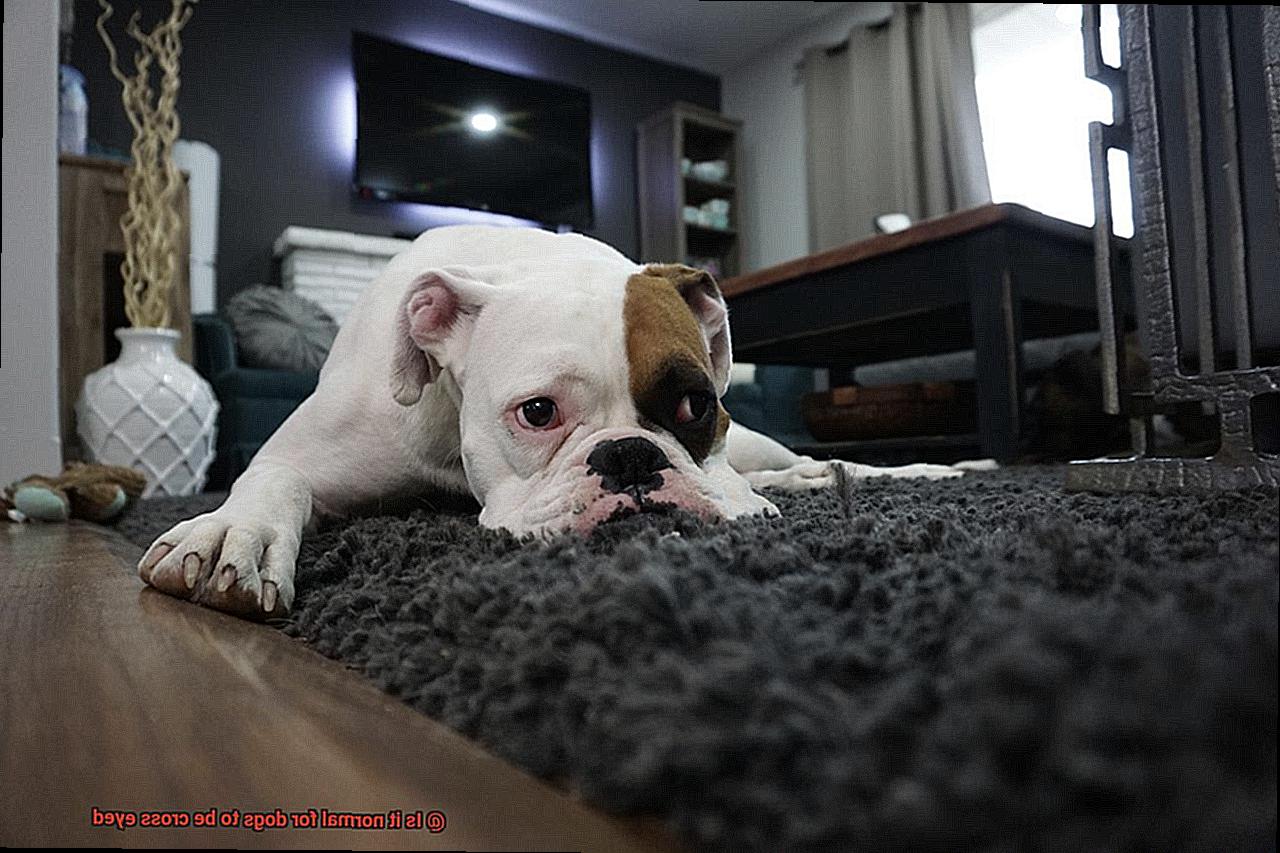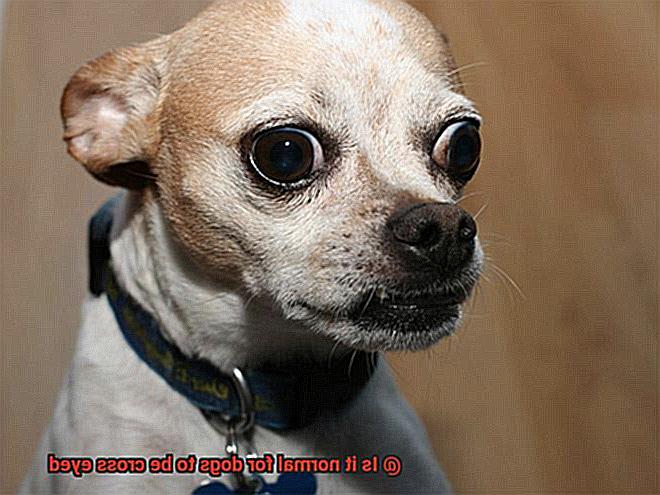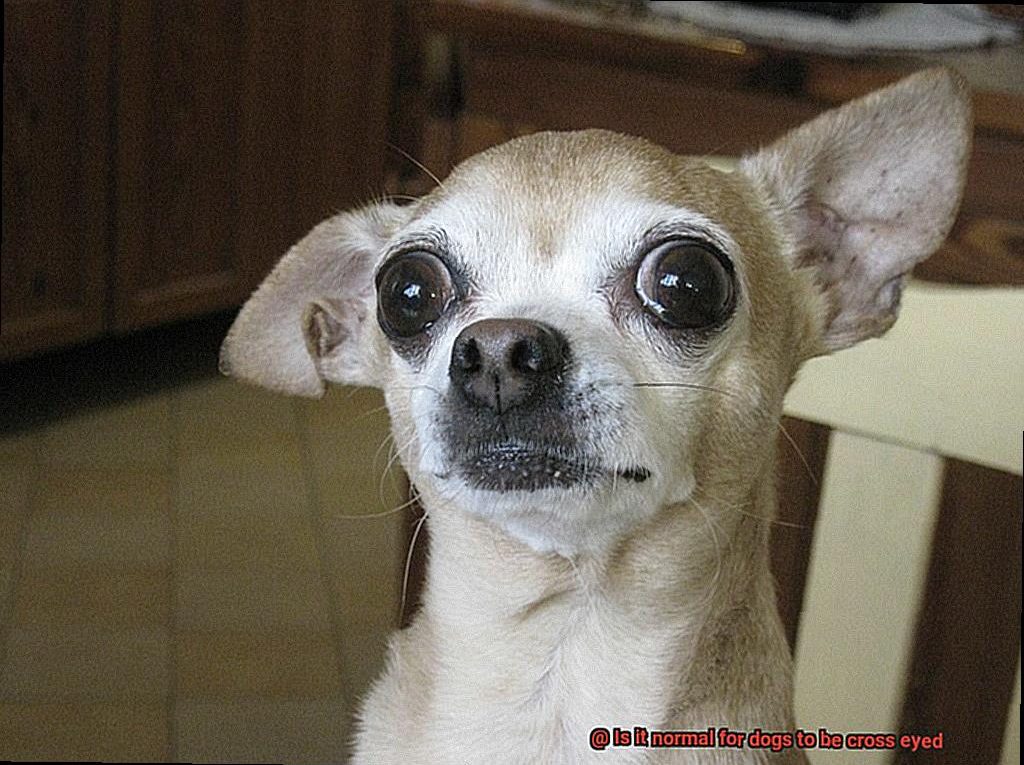Is it normal for dogs to be cross eyed?
Dogs are known for their lovable quirks and unique physical features. One of these peculiarities is crossed eyes, which can be both adorable and perplexing. But here’s the burning question: are crossed eyes in dogs normal or a cause for concern? In this blog post, we’ll dive into the prevalence of this condition, possible causes, and available treatments to shed some light on this intriguing topic.
Crossed eyes, technically called strabismus, occur when a dog’s peepers don’t line up correctly and seem to be looking in different directions. It might initially make you do a double take, but fear not. This condition is actually quite common in certain dog breeds. However, it’s crucial to distinguish between naturally crossed eyes and those caused by an underlying health issue.
A variety of factors can contribute to crossed eyes in dogs. Some breeds like Pugs, Boston Terriers, and Bulldogs may have a higher chance of being cross-eyed due to their genetics. Additionally, injuries, infections, or neurological disorders could also lead to this eye-catching phenomenon.
The approach to treating crossed eyes depends on the cause and severity of the condition. In mild cases where vision isn’t greatly affected, no intervention may be necessary as many dogs live perfectly happy lives with their quirky peepers.
However, if crossed eyes impede a dog’s vision or overall well-being significantly, there are options available such as surgery, medication, or even vision aids.

While your four-legged friend’s crossed eyes might make them stand out from the pack (pun intended), it’s important to keep an eye out for any changes in their vision or signs of discomfort. Consulting with a veterinarian is always wise to determine the root cause behind those adorable peepers and decide on the best course of action.
In the upcoming sections of this blog post, we’ll delve deeper into the prevalence of crossed eyes, explore potential causes, and discuss available treatments. Understanding this condition is key to ensuring your furry friend’s happiness and overall health.
Stay tuned for our next blog post where we’ll uncover more fascinating facts about crossed eyes in dogs.
Causes of Crossed Eyes in Dogs
Contents
- 1 Causes of Crossed Eyes in Dogs
- 2 Types of Strabismus in Dogs
- 3 Is it Normal for Dogs to be Cross Eyed?
- 4 Breeds Prone to Crossed Eyes
- 5 Diagnosing Crossed Eyes in Dogs
- 6 Treatment Options for Crossed Eyes in Dogs
- 7 Prevention and Management of Crossed Eyes in Dogs
- 8 When to See a Veterinarian for Crossed Eyes
- 9 Conclusion
Crossed eyes, also known as strabismus, can affect dogs of various breeds. While it may be concerning to see your furry friend with crossed eyes, it is important to understand that it is not uncommon and often not a cause for major concern. In this article, we will explore the causes of crossed eyes in dogs and discuss how to care for your cross-eyed canine companion.
- Congenital Factors: Some dogs are born with crossed eyes due to genetic factors or developmental issues during fetal growth. Breeds like Boston Terriers, Pugs, and French Bulldogs have a higher predisposition to this condition.
- Injury or Trauma: Crossed eyes can occur as a result of head injuries or severe blows to the face. These incidents disrupt the alignment of the eyes and lead to strabismus.
- Neurologic Disorders: Certain neurologic conditions interfere with the coordination between the eye muscles, causing a cross-eyed appearance in dogs.
- Underlying Health Conditions: Inflammation or infections in the eyes can cause discomfort and abnormal eye movements, leading to crossed eyes as a secondary symptom.
- Medications or Drugs: Some medications or drugs may have side effects that affect eye muscle control and coordination, resulting in crossed eyes.

Care for Cross-Eyed Dogs:
- Veterinary Consultation: If you notice your dog has crossed eyes, it is crucial to consult a veterinarian. They will conduct a thorough examination and run appropriate diagnostic tests to determine the underlying cause and develop an appropriate treatment plan.
- Monitoring: In mild cases, no treatment may be necessary other than regular monitoring by a veterinarian to ensure the condition does not worsen or cause discomfort.
- Treatment Options: Treatment for crossed eyes depends on the underlying cause and severity of the condition. In some cases, corrective lenses or medications may be prescribed. Surgical intervention may be considered for severe cases or when crossed eyes impact vision or overall quality of life.
Types of Strabismus in Dogs
If you own a dog, you may have noticed that their eyes occasionally appear misaligned. This condition, known as strabismus, can manifest in different forms. In this article, we will delve into the distinct types of strabismus that can affect dogs and provide you with valuable information to help you understand this condition.
Esotropia: The Inward Gaze
Esotropia is the most common type of strabismus in dogs. With esotropia, one or both eyes deviate inward towards the nose, resulting in a cross-eyed appearance. While mild esotropia may be considered normal for certain breeds like French Bulldogs, severe cases can cause discomfort or vision problems.
Exotropia: The Outward Wanderer
Unlike esotropia, exotropia involves one or both eyes pointing outward away from the nose. Although less common in dogs, exotropia can affect breeds like French Bulldogs. Regular monitoring of your dog’s eyes is crucial, as severe exotropia can lead to vision impairment and potential eye strain.
Hypertropia: The Uneven Gaze
Hypertropia occurs when one eye is higher than the other. This misalignment can cause an uneven gaze, with one eye appearing elevated or lifted compared to the other. Although less frequently seen than esotropia or exotropia, hypertropia can affect dogs of any breed, including French Bulldogs.

Alternating Strabismus: The Shifting Gaze
Dogs with alternating strabismus have a tendency to switch between crossed and uncrossed eyes. This can occur spontaneously or in response to certain stimuli such as stress or fatigue. Alternating strabismus is often observed in dogs with congenital abnormalities affecting their eye muscles. French Bulldogs can occasionally be affected by this type of strabismus.
Cyclovertical Strabismus: The Tilted View
Cyclovertical strabismus involves a tilt of the eyes in a cyclovertical direction, where they rotate around the vertical axis instead of being horizontally misaligned. This form of strabismus can be congenital or acquired and might be associated with underlying neurological conditions. While less common, it is crucial to be aware of this type of strabismus, especially if you own a French Bulldog.
Is it Normal for Dogs to be Cross Eyed?
If so, you may be wondering if it is normal for dogs to have crossed eyes. In this informative article, we will delve into the captivating world of canine strabismus, shedding light on why crossed eyes are not considered normal in dogs. We will explore the breeds most prone to this condition, such as French Bulldogs, and discuss available treatment options for concerned pet owners.
Understanding Canine Strabismus:
- Crossed eyes demystified: Crossed eyes, scientifically known as strabismus, occur when the muscles responsible for eye movement become imbalanced, causing one or both eyes to deviate inward or outward.
- Breeds with a predisposition to strabismus: Certain dog breeds, including French Bulldogs, Pugs, and Boston Terriers, are more susceptible to developing crossed eyes.
- Impaired vision and coordination challenges: Strabismus can significantly affect a dog’s depth perception and coordination, making it difficult for them to accurately judge distances or track moving objects.
Causes and Treatment Options:
- Developmental and acquired strabismus: Crossed eyes can be present at birth or develop later in life due to factors such as injury, nerve damage, or underlying medical conditions.
- Consulting a veterinarian: If your dog is born with or develops crossed eyes, it is crucial to seek professional advice from a veterinarian. They can identify the underlying cause and recommend suitable treatment options.
- Surgical intervention: In severe cases or when an underlying condition requires correction, surgical intervention may be necessary to improve eye alignment and enhance overall vision.
The Importance of Regular Eye Examinations:
- Early detection and proactive management: Regular eye examinations conducted by a veterinarian are vital for promptly detecting and managing any potential eye conditions.
- Monitoring changes: As responsible dog owners, it is essential to monitor our pets’ eye alignment and seek veterinary attention if we notice persistent or worsening cross-eyed appearances.
Breeds Prone to Crossed Eyes
French Bulldogs, along with other brachycephalic breeds like Pugs and Boston Terriers, have a unique face structure that makes them more prone to this condition. Their short snouts and wider-set eyes can result in misalignment and the occasional crossing of those precious peepers.
But let’s not forget about the other breeds in the doggie world. Take a moment to imagine a Basset Hound with its droopy skin and loose facial muscles. Unfortunately, these lovable hounds are also at a higher risk for crossed eyes.
And what about those Chinese Crested dogs? With their hairless bodies and tufts of hair on their heads and tails, they may be unique, but they are also more susceptible to this eye condition. Even our beloved Cocker Spaniels, despite being generally healthy pups, can occasionally experience crossed eyes due to their rounded skull shape and those large, soulful eyes that we all adore.
Now, before you start worrying about your furry friend’s eyesight, remember that being prone to crossed eyes doesn’t mean they will definitely develop this condition. Regular check-ups with your vet will help catch any potential eye issues early on and ensure your pup’s vision stays clear and sharp.

In our next blog post, we’ll dive deeper into the causes and symptoms of crossed eyes in dogs. We’ll also explore available treatments and solutions for this condition. So stay tuned for more information on how to take care of your furry friend’s precious peepers.
Diagnosing Crossed Eyes in Dogs
Dogs are our faithful and lovable companions, but sometimes they face health challenges just like humans do. One such challenge is crossed eyes, also known as strabismus. In this article, we will delve into the process of diagnosing crossed eyes in dogs, exploring the diagnostic tools used by veterinarians and potential treatment options available.
The Diagnostic Journey:
Diagnosing crossed eyes in dogs requires the expertise of a veterinarian specialized in ophthalmology. They meticulously examine the dog’s eyes, searching for any signs of misalignment or unusual movements. To gain deeper insights, they may employ a range of tests to assess the dog’s visual acuity and identify any underlying health issues.

The Hirschberg test is a popular diagnostic tool used by veterinarians. This test involves shining a light into the dog’s eyes and carefully observing the reflection on the corneas. If the reflections appear off-center in the pupils, it could indicate misalignment of the eyes.
In some cases, additional tests like bloodwork, imaging studies, or referral to a veterinary ophthalmologist may be necessary to uncover the root cause of crossed eyes.
Causes and Treatment Options:
Crossed eyes can stem from various factors such as genetic predisposition, eye muscle trauma or injury, neurological conditions, or developmental abnormalities. Once a diagnosis has been determined, treatment options are tailored to address the underlying cause and severity of the condition.
In instances where the misalignment does not impact vision or overall health, no treatment may be required. However, if intervention is necessary, surgical correction of eye muscle alignment or management of underlying health issues might be recommended.
The Importance of Regular Follow-up:
After diagnosis and treatment, regular follow-up visits with a veterinarian play a vital role in monitoring the condition and assessing treatment effectiveness. These visits also provide an opportunity to address any associated symptoms or complications, such as dry eyes or eye infections.
Treatment Options for Crossed Eyes in Dogs
Our furry companions deserve the best care possible, which includes addressing any health concerns they may have. If you notice that your dog, particularly a French Bulldog, has crossed eyes, also known as strabismus, there are treatment options available. This article explores the various approaches to treating crossed eyes in dogs, focusing on the adorable French Bulldogs.
Understanding Crossed Eyes in Dogs:
Crossed eyes occur when the eyes fail to align properly, and while it may not be a common condition in dogs, certain breeds like French Bulldogs are more susceptible to it. It is important to note that not all cases of crossed eyes require treatment, especially if your furry friend is not experiencing any discomfort or vision impairment.
Corrective Eyewear: Stylish Solutions for Improved Vision:
Believe it or not, dogs can now sport fashionable glasses or contact lenses just like humans. Specially designed eyewear can help align their eyes correctly, enhancing their vision and minimizing any discomfort caused by crossed eyes. Just imagine your French Bulldog strutting their stuff with a trendy pair of glasses.
Surgical Intervention: When Precision is Paramount:
In severe cases where crossed eyes significantly affect your dog’s quality of life, surgical intervention may be recommended. The primary objective of surgery is to realign the eyes and improve their functionality. However, it is crucial to consult with a veterinary ophthalmologist who specializes in eye conditions in animals before considering surgery.
Monitoring and Regular Eye Examinations:
Although treatment options exist, it is important to remember that not all cases of crossed eyes require intervention. Dogs can adapt and lead normal lives without treatment. Nonetheless, regular eye examinations by a veterinarian are essential to monitor the progression of crossed eyes and detect any underlying eye conditions that may necessitate treatment.
Prevention and Management of Crossed Eyes in Dogs
There’s no denying the irresistible charm of French Bulldogs, with their squished faces and big round eyes. However, these unique physical traits also make them more susceptible to certain health issues, including crossed eyes or strabismus.
As responsible owners, it is crucial to understand how we can prevent and manage this condition to ensure the well-being of our furry friends.
Responsible Breeding Practices:
Choosing a reputable breeder who prioritizes the health and welfare of their dogs is the first step in preventing crossed eyes. Look for breeders who conduct thorough health screenings on their breeding pairs, including eye examinations, to minimize the risk of passing on genetic eye disorders.
Regular Veterinary Check-ups:
Routine veterinary check-ups are essential for early detection and intervention. Your veterinarian can perform comprehensive eye examinations to assess your dog’s ocular health and identify any signs of crossed eyes. Early detection allows for prompt treatment and helps prevent further progression and potential complications.
Proper Nutrition:
Proper nutrition plays a vital role in maintaining overall eye health in dogs. Ensure that your furry friend receives a balanced diet that includes essential nutrients like vitamin A and omega-3 fatty acids. These nutrients support healthy eye development and function, reducing the likelihood of eye abnormalities, including crossed eyes.
Trauma Prevention and Management:
Protecting your dog from eye injuries is crucial in preventing crossed eyes. Create a safe environment by keeping them away from sharp objects, hazardous chemicals, or rough play with other dogs.
Regular Eye Examinations:
Regular eye examinations by a veterinarian specializing in ophthalmology are essential for monitoring the progression of crossed eyes in dogs. Your veterinarian will assess the severity of the condition and recommend suitable management options, such as eye lubricants to prevent dryness and discomfort, corrective lenses, or even surgery in severe cases.
Remember, as responsible owners, it is our duty to stay vigilant and proactive in caring for our dogs. If you notice any changes in your dog’s eyes, such as increased redness, discharge, or discomfort, seek professional advice immediately. By following these preventive measures and actively managing crossed eyes if they occur, we can ensure our beloved pets lead happy and healthy lives.
When to See a Veterinarian for Crossed Eyes
French Bulldogs are undeniably cute with their squished faces and big round eyes. However, these unique features can make them more prone to certain eye conditions, including crossed eyes or strabismus. While it may be tempting to brush off slight eye misalignment as a charming quirk, it’s important to know when to seek veterinary care for this condition. In this article, we’ll discuss when to consult a veterinarian for crossed eyes in French Bulldogs and provide helpful tips for prevention and management.
Understanding Crossed Eyes in French Bulldogs:
Crossed eyes, also known as strabismus, can occur in dogs for various reasons. In French Bulldogs, this condition is often a result of their brachycephalic (short-nosed) skull structure. The misalignment of the eye muscles can cause the eyes to point in different directions, leading to crossed eyes.
When to Seek Veterinary Care:
- Sudden Onset or Severe Crossed Eyes: If you notice a sudden change in your French Bulldog’s eye alignment or if their crossed eyes are severe, it’s crucial to seek veterinary attention promptly. This could be indicative of an underlying issue that requires immediate evaluation and treatment.
- Accompanying Symptoms: If your French Bulldog’s crossed eyes are accompanied by other concerning symptoms such as difficulty seeing, eye pain, or changes in behavior, it’s best to err on the side of caution and consult with a veterinarian.
- Regular Check-ups: Even if your French Bulldog has a slight misalignment of the eyes due to breed characteristics, regular check-ups with a veterinarian are essential. They can monitor your dog’s condition and ensure appropriate management.
Veterinary Examination and Treatment:
During a veterinary visit for crossed eyes, the veterinarian will conduct a comprehensive examination of your French Bulldog’s eyes. They will assess their vision, check for any abnormalities or underlying conditions, and determine the extent of the eye misalignment. Additional diagnostic tests such as blood work or imaging may be performed to further evaluate your dog’s condition.
Treatment for crossed eyes in French Bulldogs depends on the underlying cause and severity of the condition. In some cases, no treatment may be necessary if the crossed eyes do not affect your dog’s overall health or well-being. However, if treatment is warranted, it may involve medications to manage any underlying medical conditions, surgical correction to realign the eye muscles, or a combination of both.
Prevention and Management:
Breed Selection: If you are considering getting a French Bulldog, choose a reputable breeder who prioritizes the health and well-being of their dogs. Responsible breeders will conduct appropriate health screenings to minimize the risk of genetic eye conditions.
VAIwxzEHxZM” >
Conclusion
In conclusion, it is not normal for dogs to be cross-eyed.
While some breeds may have a genetic predisposition to certain eye conditions, such as strabismus, it is still considered an abnormality. Cross-eyed dogs may experience difficulty with depth perception and coordination, affecting their overall quality of life.
If you notice your dog exhibiting signs of crossed eyes, such as misalignment or wandering gaze, it is important to consult with a veterinarian for proper diagnosis and treatment options.




